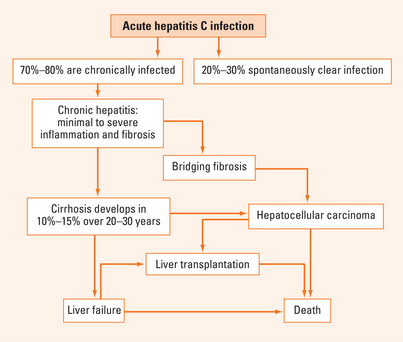Chapter 35 THE HEPATITIS C-POSITIVE PATIENT
EPIDEMIOLOGY
Prevalence and natural history
The prevalence of hepatitis C virus (HCV) infection varies worldwide with relatively low prevalence in North America and Europe compared with higher prevalence in Asia and southern Europe. The prevalence in Australia is approximately 0.1%, making HCV infection a common cause of chronic liver disease. Recent estimates from the Hepatitis C Projections Working Group 2006 suggest that around 200,000 people were chronically infected with the virus at the end of 2005 in Australia and that the prevalence will triple over the next 20 years. Of chronically infected individuals, 10%–15% will develop liver cirrhosis over a 20-year period. Once cirrhosis is established, hepatocellular carcinoma (HCC) develops at an annual incidence of 2%. In most countries where data are available, HCV infection is the leading cause of liver transplantation. The Hepatitis C Projections Working Group concluded that the current number of people receiving treatment would need to be increased three-fold to reduce the proportion of patients living with advanced liver disease due to HCV infection.
VIROLOGY
HCV is classified on the basis of similarity of nucleotide sequence into major genetic groups designated genotypes. A recent reclassification has resulted in six major genotypes with a number of subtypes that vary geographically. Genotypes 1, 2 and 3 are common in North America, Europe, Japan and Australia; genotype 4 is common in the Middle East including Egypt, genotype 5 in South Africa and genotypes 6 and its subtypes in Asia. All major genotypes have been identified in Australia, although genotypes 1 and 3 are more common.
CLINICAL COURSE OF HCV INFECTION
Acute HCV infection
Acute HCV infection is commonly asymptomatic and thus infrequently recognised clinically. Systematic reviews suggest that approximately 25% of patients may spontaneously clear acute HCV infection although the exact proportion is unclear. Acute HCV may be associated with a clinical syndrome of fatigue, lethargy, low-grade fever and right upper quadrant discomfort. Serum HCV RNA typically becomes detectable 7–21 days after exposure and specific antibodies appear subsequently. Jaundice occurs in less than 20% of acute infections. Interestingly, the patients who develop clinically apparent acute hepatitis clear the virus and avoid chronic disease with greater frequency than those who have clinically silent disease (see Treatment section). The host and viral factors that influence resolution of HCV infection remain unclear.
Chronic HCV infection
The majority of persons exposed to HCV will develop chronic infection with persistence of detectable serum HCV RNA for more than 6 months. A certain proportion of these patients will have persistently normal liver function tests; in these patients the risk of progression to advanced liver diseases is low. In patients with abnormal alanine aminotransferase (ALT), the overall fibrosis progression rates are higher and some will progress through increasing stages of fibrosis to cirrhosis (Figure 35.1).










